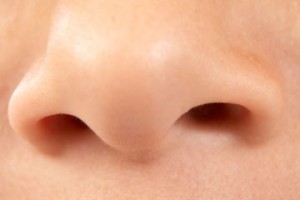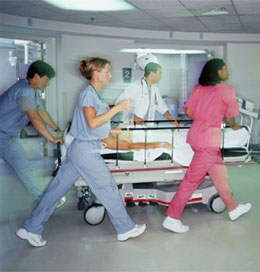Smell
 After rotating in internal medicine for the past two months, it’s clear to me that medicine is an art that requires the awareness of all the senses… Through vision we can detect any lesions, changes of color, and general health of our patients. Through touch we can determine the location, size, shape, and texture of an abnormal mass or organ. Through our ears we can distinguish between types and degrees of heart murmurs or lung congestions. We can even determine any enlargements or shifts of position of organs via our ears when we percuss. In past times, we as the medical profession used to taste the urine of patients to detect diabetes (or so the legend goes). Thank goodness we don’t do that anymore. However, another sense I am starting to learn more and more about in my rotations is the often forgotten, but nevertheless important sense of smell. Smells can tell you a lot about a situation, and the hospital has tons of them, not all of which are pleasant. There are the smells of patient hygiene, smells of excrement, and most importantly, smells of diseases.
After rotating in internal medicine for the past two months, it’s clear to me that medicine is an art that requires the awareness of all the senses… Through vision we can detect any lesions, changes of color, and general health of our patients. Through touch we can determine the location, size, shape, and texture of an abnormal mass or organ. Through our ears we can distinguish between types and degrees of heart murmurs or lung congestions. We can even determine any enlargements or shifts of position of organs via our ears when we percuss. In past times, we as the medical profession used to taste the urine of patients to detect diabetes (or so the legend goes). Thank goodness we don’t do that anymore. However, another sense I am starting to learn more and more about in my rotations is the often forgotten, but nevertheless important sense of smell. Smells can tell you a lot about a situation, and the hospital has tons of them, not all of which are pleasant. There are the smells of patient hygiene, smells of excrement, and most importantly, smells of diseases.
After seeing countless patients, you eventually pick up what different things smell like. I’ve seen my attending come into a room, and immediately know what organism is causing the patient’s diarrhea, through the unique egg-like smell of clostridium difficile, and treat the patient accordingly. Another of my attendings was able to come into the examination room, and suspect a vaginal infection in a patient simply from the smell of the room, before even a physical exam. I’ve smelled a few gangrenous lesions as well, and it is probably the worst out of the bunch.
So as you can see, smell can be another revealing dimension in the art of diagnosis. In fact, a machine has been invented recently to analyze the odors of stool samples to identify different gastrointestinal infections. The Odoreader is still undergoing clinical trials, but has the potential to be a fast and inexpensive method of diagnosis, and can possibly even be used in the future for respiratory and urinary diseases as well.
Here are some other smells to take note of in medicine:
- Ketoacidosis — fruity odor, due to acetone from ketosis.
- Pseudomonas — grape-like odor.
- Phenylketonuria (PKU) — “mousy” smell (what exactly does a mouse smell like? a pet store?)
- Arsenic poisoning — garlic smell. Don’t confuse it with someone who just ate garlic bread.
- Cyanide poisoning — burnt almond smell.
On a related note, wouldn’t it be cool if a smell-generating machine is invented that could be used in medical school to teach what different infections, conditions, and diseases smell like?










Hi Benji,
I have been following ur blog for a little while now. I am currently attending pharmacy school, but after my first rotation in a hospital, i have set my heart on med school. AUC is definitely one of the options I am considering. Could you give me some advice on as being a pharm student applying for med school? I am currently looking at AUC and spartans due to the fact that I am not really sure what I can get on MCAT. Did you ever consider Spartans when you were applying? Do you happen to know anyone from Spartans? I apologize for all these questions, I am very much as a loss right now with all these options that’s out there.
I am looking forward to hearing back from you at your earliest connivence.
Sam
Hi Samantha,
I’m glad to hear you’re having a great time in hospital rotations. If you are thinking about applying to medical school, I would definitely make sure you have all the pre-med pre-requisites, and study well for the MCAT and take it. If you are considering coming to the Caribbean, I would highly suggest applying first to the Big 4 schools (AUC, SGU, Ross, Saba) as they are approved in all 50 states and offers Title IV federal student loans, and are the oldest and most established off-shore medical schools in the Caribbean. If not these, the next ones I would apply to is AUA, which is approved in all states but Kansas (until 2019) but does not have Title IV federal student loans. AUA, in particular, does not require MCAT from what I understand, so if MCAT is something you are worried about, you could consider applying here. But I would still try to take the MCAT.
I would not recommend applying to anywhere else beyond these schools. Spartan, in particular, has been disapproved by California and every state that follows the California list. Graduates from Spartan, therefore, cannot get licensed to practice medicine in Alaska, Arkansas, Colorado, Kansas, Idaho, Indiana, New Mexico, Oregon, Tennessee, Vermont, Alabama, North Dakota, and perhaps some other states as well. The same goes with St. Matthew’s University (SMU) and UHSA.
Please check out my post about the accreditation process of Caribbean medical schools: http://www.caribbeanmedstudent.com/2009/09/the-accreditation-process-of-caribbean-medical-schools/ . It’s a lengthy post, but an important one.
Best of luck!
Benji
Thanks, Benji!
I wasn’t expecting that you would reply that fast. I really appreciate your insights. I honestly don’t feel like to take MCAT just because I have just finished my first year of pharm school, the summer before was PCAT. Really would love to take a break sorta. But I have already gotten some study material for MCAT, might as well study.
By the way, I kept hearing rumors about residency. If it true that it’s really hard to get a match being a foreign medical school graduate?
Thanks
Sam
Hey Samantha,
I’d say it is more difficult getting a match in a competitive specialty as a foreign grad, like radiology, dermatology, etc. However, it shouldn’t be too bad in IM or Family Medicine. Most AUC grads do match somewhere, and every year there are those who match in competitive specialties. If you get high scores like in the 240’s or 250’s, then the doors are open to you in whatever field you want to go, no matter if you are a foreign grad or not. You could check the AUC website for their match list of recent graduates.
Best of luck Sam!
Benji
Thanks so much Benji!
I have definitely learned a lot from you. I appreciate that you take time to response to my questions. I will be taking MCAT this August. At any rate, I should know what I will be eventually doing. Probably will be bugging you later 🙂
Thanks!
Sam
No problem Sam! Best of luck on the MCAT this August! 🙂